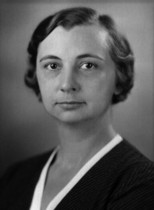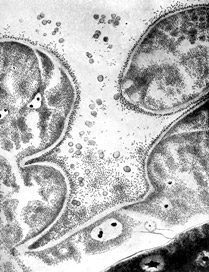Rickettsia prowazekii Reproduces Only in Living Cells

Nigg, Clara
Courtesy of the Rockefeller Archive Center
Epidemic typhus has caused disease and death throughout history, most often under conditions of war, famine, and natural disaster. By the early 1930s scientists knew that lice transmitted the disease—the Pasteur Institute's director, Charles Nicolle received a Nobel Prize in 1928 for this discovery. And the organism that causes the disease, the bacterium Rickettsia prowazekii, had been identified. But in order to develop a vaccine, researchers needed to overcome the obstacle of growing Rickettsia in culture. Many researchers took on this problem, including Clara Nigg (1897- death date) in the laboratory of Karl Landsteiner (1868-1943) at the Rockefeller Institute.

From gut contents of louse: section showing swollen and vacuolated epithelial cells filled with Rickettsia prowazeki. From Filterable virus and ricketssia diseases by McKinley, E.
Nigg both developed methods for cultivating Rickettsia prowazekii and proved that the organism—like viruses—reproduces only in living cells. With Landsteiner, Nigg built on tissue culture techniques that had been worked out by their Rockefeller colleague Thomas Rivers for growing viruses. At the time, viruses were not well understood, and it was not known that Rickettsia prowazekii is an obligate parasite. It was dangerous work—Nigg contracted typhus during the research, and in fact became a patient at the Rockefeller Hospital. Ultimately other, more efficient, methods came into practice for culturing Rickettsia and producing vaccine. Typhus is treated today with antibiotics.
Clara Nigg received the BA in 1921 and the PhD in 1929 from the University of Kansas, Lawrence. In 1922 she supervised laboratory work at St. Bartholomew's Hospital in New York City, and in 1923 she headed a laboratory for the Minnesota State Department of Health. In 1926 and 1927 she did research at Queen's Hospital in Honolulu while conducting her PhD research on blood grouping among Polynesians. Nigg was an assistant in the laboratory of Karl Landsteiner at Rockefeller from 1929 to 1937. She then joined E.R. Squibb, where she headed the department of bacteriology and virology through the 1940s. She also served as a consultant to the U.S. Office of Scientific Research and Development.
Karl Landsteiner received the MD from the University of Vienna in 1891, and for the next five years studied in the laboratories of prominent chemists, including Emil Fischer. In 1897 he became assistant to the director of the Pathological Anatomical Institute in Vienna. He continued his research at this and subsequent posts until 1922, when Simon Flexner invited him to become a member of the Rockefeller Institute. Landsteiner was awarded the Nobel Prize in 1930 for his discovery of the major blood groups. A pioneer immunologist, he also discovered the Rh factor in blood. Landsteiner remained at Rockefeller until his death in 1943.
Selected Publications
Nigg C and Landsteiner K. Growth of Rickettsia of typhus fever (Mexican type) in the presence of living tissue. Proc Soc Exp Biol Med, 1930, 28: 3-5
Nigg C and Landsteiner K. Studies on the cultivation of the typhus fever Rickettsia in the presence of live tissue. J Exp Med, 1932, 55: 563-576
http://www.jem.org/cgi/reprint/55/4/563
Nigg C. On the preservation of typhus fever Rickettsiae in cultures. J Exp Med, 1935, 61: 17-26
http://www.jem.org/cgi/reprint/61/1/17
Nigg C. Studies on culture strains of European and murine typhus. J Exp Med, 1936, 63: 341-351
http://www.jem.org/cgi/reprint/63/3/341
Further Reading
Benison S. Tom Rivers: Reflections on a Life in Medicine and Science. An Oral History Memoir. Cambridge, MA: The MIT Press, 1967
